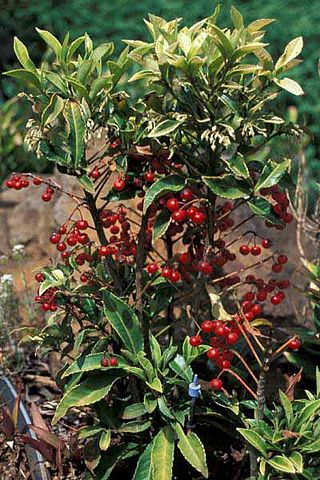
Myrsinoideae is a subfamily of the family Primulaceae in the order Ericales. It was formerly recognized as the family Myrsinaceae, or the myrsine family, consisting of 35 genera and about 1000 species. It is widespread in temperate to tropical climates extending north to Europe, Siberia, Japan, Mexico, and Florida, and south to New Zealand, South America, and South Africa.

Cinnamomum is a genus of evergreen aromatic trees and shrubs belonging to the laurel family, Lauraceae. The species of Cinnamomum have aromatic oils in their leaves and bark. The genus contains approximately 250 species, distributed in tropical and subtropical regions of South Asia, Southeast Asia, East Asia and Oceania/Australasia. The genus includes a great number of economically important trees used to produce the spice of cinnamon.
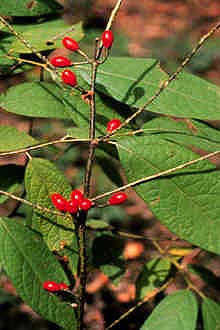
Lindera is a genus of about 80–100 species of flowering plants in the family Lauraceae, mostly native to eastern Asia but with three species in eastern North America. The species are shrubs and small trees; common names include spicewood, spicebush, and Benjamin bush.

The Hernandiaceae are a family of flowering plants (angiosperms) in the order Laurales. Consisting of five genera with about 58 known species, they are distributed over the world's tropical areas, some of them widely distributed in coastal areas, but they occur from sea level to over 2000 m.

Actinodaphne is an Asian genus of flowering plants in the laurel family (Lauraceae). It contains approximately 125 species of dioecious evergreen trees and shrubs.
This page provides a glossary of plant morphology. Botanists and other biologists who study plant morphology use a number of different terms to classify and identify plant organs and parts that can be observed using no more than a handheld magnifying lens. This page provides help in understanding the numerous other pages describing plants by their various taxa. The accompanying page—Plant morphology—provides an overview of the science of the external form of plants. There is also an alphabetical list: Glossary of botanical terms. In contrast, this page deals with botanical terms in a systematic manner, with some illustrations, and organized by plant anatomy and function in plant physiology.
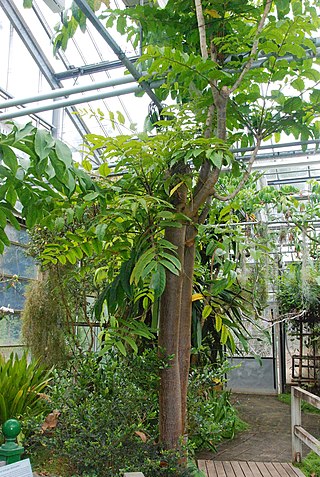
Polyscias aemiliguineae is a species of plant in the family Araliaceae. It is endemic to Réunion.

Acacia howittii, commonly known as sticky wattle or Howitt's wattle, is a tree species that is endemic to Victoria, Australia.
Hypodaphnis is a monotypic genus of flowering plants of the family Lauraceae. Its only extant species, Hypodaphnis zenkeri, is native to Gabon. Although only one living species is known, fossils of some species of this genus are present in North America, especially in Northern Mexico. In most phylogenetic analysis, Hypodaphnis appears as the basal branch, the sister group of the rest of the family Lauraceae.

Adenodaphne is a genus of shrubs and small trees endemic to New Caledonia belonging to the family Lauraceae. The genus is related to Litsea. They have 12 chromosomes.
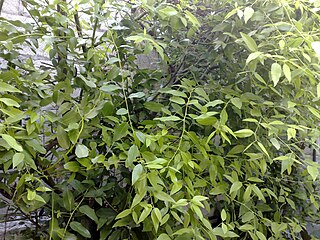
Litsea glaucescens, also called Mexican bay leaf, is an evergreen tree or shrub 3–6 metres (9.8–19.7 ft) high in the genus Litsea belonging to family Lauraceae. It is native from southern North America, mostly in Mexico. Distributed by Mexico and Central America.
Cinnadenia is a flowering plant genus belonging to the family Lauraceae. They are present in low and mountain cloud forest in Southeast Asia.
Syndiclis is a genus of flowering plants in the family Lauraceae. It contains ten species, which are native to China, Vietnam and Hainan, and Bhutan.
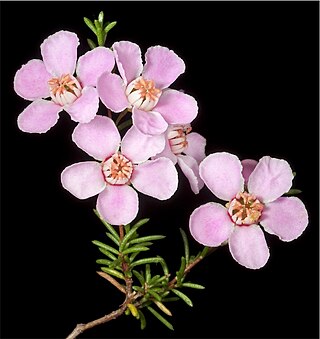
Babingtonia is a genus of 11 species of flowering plants in the myrtle fmily, Myrtaceae and is endemic to the south-west of Western Australia. Plants in the genus Babingtonia are glabrous shrubs with simple linear, lance-shaped or elliptic leaves with white flowers arranged singly or in groups of three to seven, in leaf axils.

Eugenia myrcianthes or ubajay is a species of plant in the family Myrtaceae found in Argentina, Bolivia, Brazil, Paraguay and Uruguay.

Cinnamomum kanehirae, also known as small-flowered camphor tree, or stout camphor tree, is a tree within the genus Cinnamomum of the family Lauraceae endemic to Taiwan.
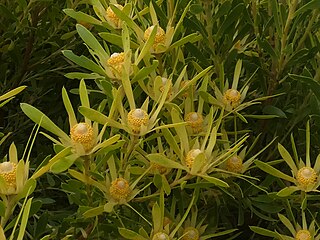
Leucadendron coniferum, also known at the dune conebush, is an evergreen, dioecious shrub or small tree of up to 4 m (13 ft) high, that has been assigned to the family Proteaceae. It has a whorl of conspicuous yellow leaves subtending the flowerheads. The flowers can be found in August and September. It grows in sandy soils near the coast of the Western Cape province of South Africa.

Prunus himalayana, called jyokun shin in Tibetan and 喜马拉雅臭樱 in Chinese, is a species of Prunus native to Nepal, Bhutan, Sikkim and Tibet. It prefers to grow 2,800 to 4,200 m above sea level in the Himalayas. As Maddenia himalaica it was the type species for the now unrecognized genus Maddenia.
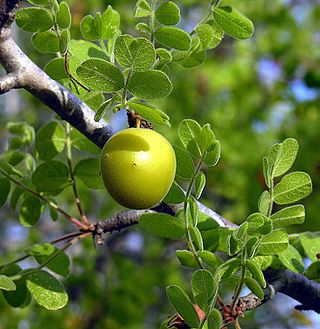
Cyrtocarpa edulis is a species of perennial sarcocaulescent tree commonly known as the Cimarrón plum or Cape wild-plum. It is in the genus Cyrtocarpa, and is endemic to Baja California Sur. This plant is characterized by fleshy stems, twisted branches and an edible drupe.
Dansiea elliptica is a species of rainforest tree which is endemic to Queensland, Australia. The species, which occurs within two highly disjunct centres of distribution, is primarily found in drier notophyll vine forests and semi evergreen vine thickets in the Wet Tropics of Queensland and Central Queensland. The species is listed as Near Threatened under the Queensland Nature Conservation Act (1992) and has a total area of occupancy of less than 40 square km.














